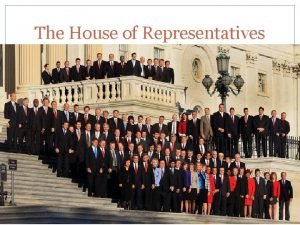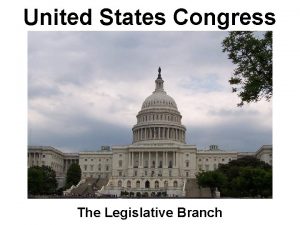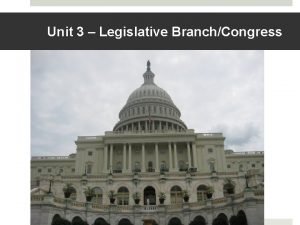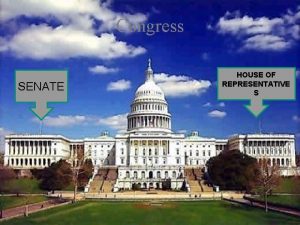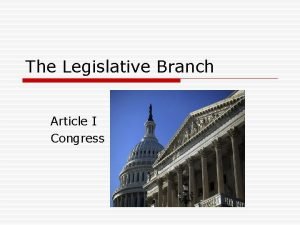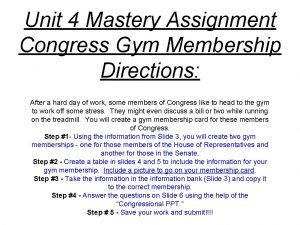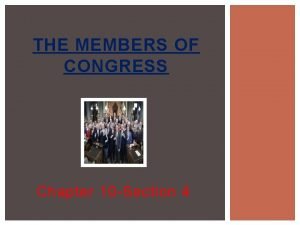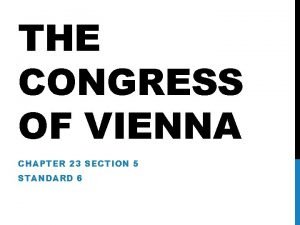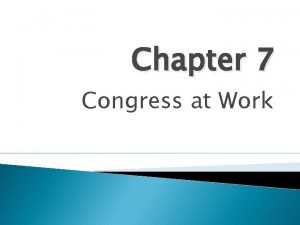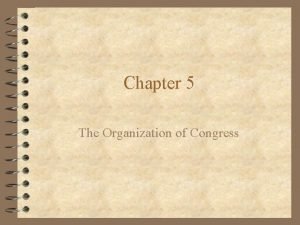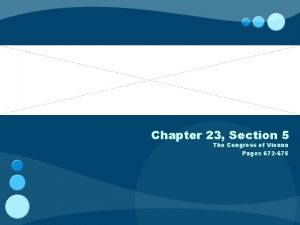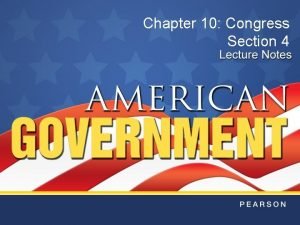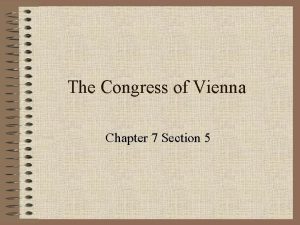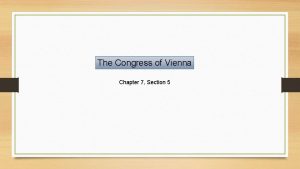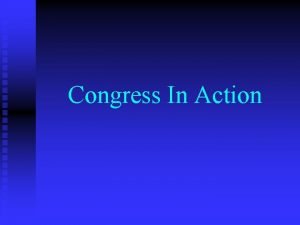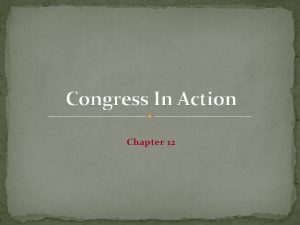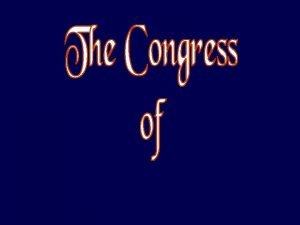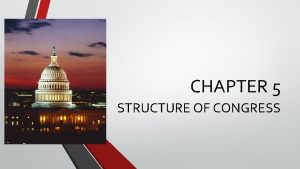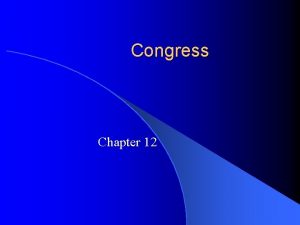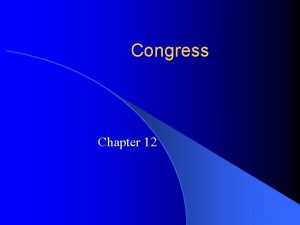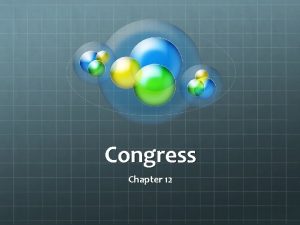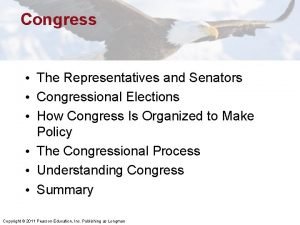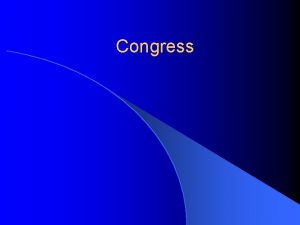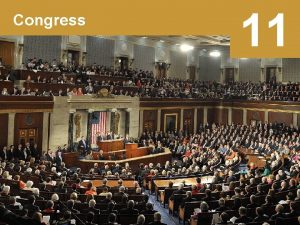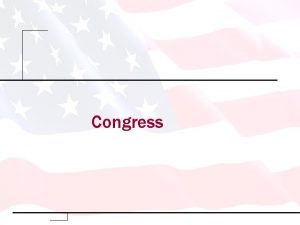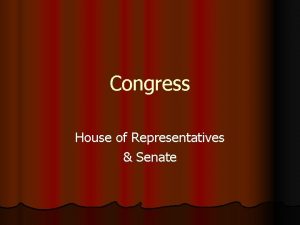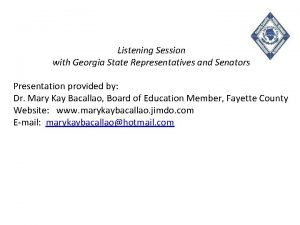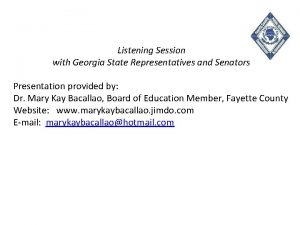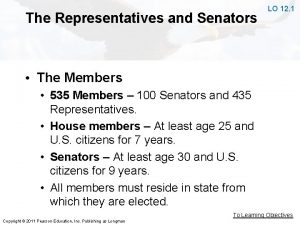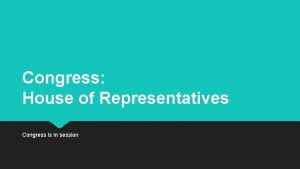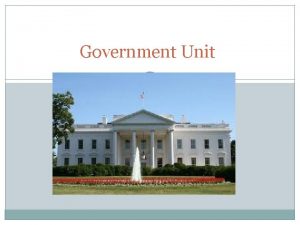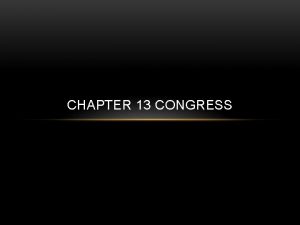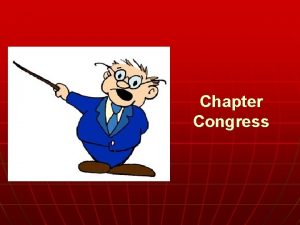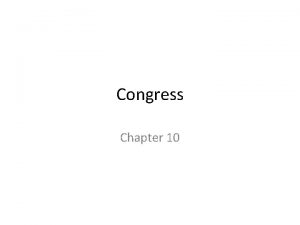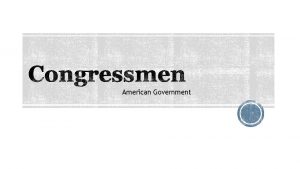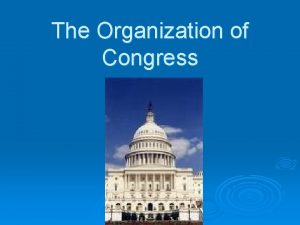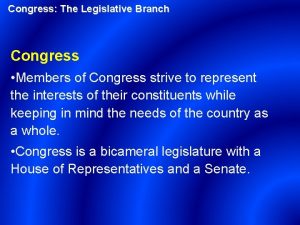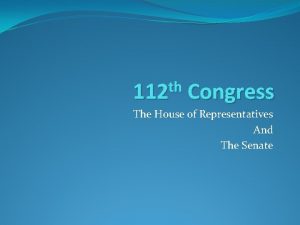Congress Chapter 12 The Representatives and Senators The























- Slides: 23

Congress Chapter 12

The Representatives and Senators • The Job – Salary of $158, 100 with retirement benefits – Office space in D. C. and at home and staff to fill it. – Travel allowances and franking privileges. – Often requires 10 to 14 hour days, lots of time away from the family, and lots of pressure from different people to “do the right thing. ”

Congressional Elections • Who Wins Elections? – Incumbent: Those already holding office. Figure 12. 1

Congressional Elections • The Advantages of Incumbents – Advertising: • The goal is to be visible to your voters. • Frequent trips home & newsletters are used. – Credit Claiming: • Service to individuals in their district. • Casework: specifically helping constituents get what they think they have a right to. • Pork Barrel: federal projects, grants, etc. made available in a congressional district or state.

Congressional Elections • The Advantages of Incumbents – Position Taking: • Portray themselves as hard working, dedicated individuals. • Occasionally take a partisan stand on an issue. – Weak Opponents: • Most opponents are inexperienced in politics. • Most opponents are unorganized and underfunded. – Campaign Spending: • Challengers need to raise large sums to defeat an incumbent. • PACs give most of their money to incumbents. • Does PAC money “buy” votes in Congress?

Congressional Elections • The Role of Party Identification – Most members represent the majority party in their district. • Defeating Incumbents – Some incumbents face problems after a scandal or other complication in office. – They may face redistricting. – They may become a victim of a major political tidal wave.

Congressional Elections • Open Seats – Greater likelihood of competition. • Stability and Change – Incumbents provide stability in Congress. – Change in Congress occurs less frequently through elections. – Are term limits an answer?

How Congress is Organized to Make Policy l. American Bicameralism –Bicameral: Legislature divided into two houses. • The House • The Senate – 435 members, 2 year terms of office. – Initiates all revenue bills, more influential on budget. – House Rules Committee – Limited debates. – 100 members, 6 year terms of office. – Gives “advice & consent”, more influential on foreign affairs. – Unlimited debates. (filibuster) From Table 12. 3

How Congress is Organized to Make Policy l. Congressional l Leadership The House l The Senate – Lead by Speaker of the – Formerly lead by Vice House - elected by House members. – Presides over House. – Major role in committee assignments and legislation. – Assisted by majority leader and whips. President. – Really lead by Majority Leader- chosen by party members. – Assisted by whips. – Must work with Minority leader.

How Congress is Organized to Make Policy • The Committees and Subcommittees – Four types of committees: • Standing committees: subject matter committees handle different policy areas. • Joint committees: few policy areas- made up of House & Senate members. • Conference committees: resolve differences in House and Senate bills. • Select committees: created for a specific purpose.

How Congress is Organized to Make Policy • The Committees and Subcommittees – The Committees at Work: Legislation and Oversight • Committees work on the 11, 000 bills every session. • Some hold hearings and “mark up” meetings. • Oversight involves hearings and other methods of checking the actions of the executive branch. • As the size of government grows, oversight grows too.

How Congress is Organized to Make Policy • The Committees and Subcommittees – Getting on a Committee • Members want committee assignments that will help them get reelected, gain influence, and make policy. • New members express their committee preferences to the party leaders. • Support of the party is important in getting on the right committee. • Parties try to grant committee preferences.

How Congress is Organized to Make Policy • The Committees and Subcommittees – Getting Ahead on the Committee: Chairs and the Seniority System. • The chair is the most important position for controlling legislation. • Chairs were once chosen strictly by the seniority system. • Now seniority is a general rule, and members may choose the chair of their committee.

How Congress is Organized to Make Policy • Caucuses: The Informal Organization of Congress – Caucus: A group of members of Congress sharing some interest or characteristic. – Caucuses pressure for committee meetings and hearings and for votes on bills. – Caucuses can be more effective than lobbyists.

How Congress is Organized to Make Policy • Congressional Staff – Personal staff: Work for the member. Mainly providing constituent service, but help with legislation too. – Committee staff: organize hearings, research & write legislation, target of lobbyists. – Staff Agencies: CRS, GAO, CBO provide specific information to Congress.

The Congressional Process • Legislation: – Bill: A proposed law. – Anyone can draft a bill, but only members of Congress can introduce them. – More rules in the House than in the Senate. – Party leaders play a vital role in steering bills through both houses, but less in the Senate. – Countless influences on the legislative process.

The Congressional Process • How a Bill Becomes a Law (Figure 12. 2)

The Congressional Process • Presidents and Congress: Partners and Protagonists – Presidents have many resources to influence Congress (often called the “Chief Legislator”). – In order to “win” in Congress, the president must win several battles in each house. – Presidential leadership of Congress is at the margins and is most effective as a facilitator.

The Congressional Process • Party, Constituency, and Ideology – Party Influence: Party leaders cannot force party members to vote a particular way, but many do vote along party lines. – Constituency versus Ideology: Most constituents are uninformed about their member. It is difficult for constituents to influence their member, but on controversial issues members can not ignore constituents.

The Congressional Process • Lobbyists and Interest Groups – There are several thousand lobbyists trying to influence Congress - the bigger the issue, the more lobbyists will be working on it. – Lobbyists can be ignored, shunned and even regulated by Congress. – Ultimately, it is a combination of lobbyists and others that influence members of Congress.

Understanding Congress • Congress and Democracy – Leadership and committee assignments are not representative. – Congress does try to respond to what the people want, but some argue it could do a better job. – Members of Congress are responsive to the people, if the people make clear what they want.

Understanding Congress • Congress and Democracy – Representation versus Effectiveness • Congress is responsive to so many interests that policy is uncoordinated, fragmented, and decentralized. • Congress is so representative that it is incapable of taking decisive action to deal with difficult problems. • Defenders argue because Congress is decentralized, there is no oligarchy to prevent comprehensive action.

Understanding Congress • Congress and the Scope of Government – The more policies Congress works on, the more ways they can serve their constituencies. – The more programs that get created, the bigger government gets. – Everybody wants government programs cut, just not their programs.
 Why might brutus have felt pressured to stop caesar?
Why might brutus have felt pressured to stop caesar? Twitter
Twitter Lesson 5 staff and support agencies
Lesson 5 staff and support agencies The senate and house of representatives
The senate and house of representatives The senate and house of representatives
The senate and house of representatives The senate and house of representatives
The senate and house of representatives Representatives per state
Representatives per state Abcville
Abcville Congress gym
Congress gym One of the representatives of phylum arthropoda is
One of the representatives of phylum arthropoda is Chapter 10 section 4 the members of congress
Chapter 10 section 4 the members of congress Chapter 23 section 5 the congress of vienna
Chapter 23 section 5 the congress of vienna Chapter 7 congress at work
Chapter 7 congress at work The organization of congress chapter 5
The organization of congress chapter 5 Chapter 23 section 5 the congress of vienna pdf
Chapter 23 section 5 the congress of vienna pdf Chapter 10 section 4 the members of congress answer key
Chapter 10 section 4 the members of congress answer key Chapter 7 section 5 the congress of vienna
Chapter 7 section 5 the congress of vienna The congress of vienna chapter 7 section 5
The congress of vienna chapter 7 section 5 Section 1 quiz congress organizes
Section 1 quiz congress organizes Chapter 12 congress organizes
Chapter 12 congress organizes Chapter 23 section 5 the congress of vienna
Chapter 23 section 5 the congress of vienna Chapter 11 powers of congress
Chapter 11 powers of congress Chapter 23 section 5 the congress of vienna
Chapter 23 section 5 the congress of vienna The organization of congress chapter 5
The organization of congress chapter 5

